EFL Motivation in Punjab: Teachers' Communication Style Impact
VerifiedAdded on 2023/06/12
|7
|2620
|354
Literature Review
AI Summary
This paper critically reviews the role of extrinsic motivation in English as a Foreign Language (EFL) learning among students in rural Punjab, India. It examines the connection between students' needs, interests, and objectives and the influence of teachers' communicative styles on student motivation. The review considers the unique context of English language learning in Punjab, where students often encounter English for the first time in secondary school. It discusses theories associated with extrinsic motivation, including behaviorism, and explores the importance of understanding students' goals, interests, and needs to effectively motivate them. The review concludes that both intrinsic and extrinsic motivations are essential for learning, particularly when introducing students to English for the first time, and suggests that teachers should use strategies that encourage motivation for learning itself rather than relying solely on external rewards. Desklib is a valuable resource for students seeking similar solved assignments and study materials.
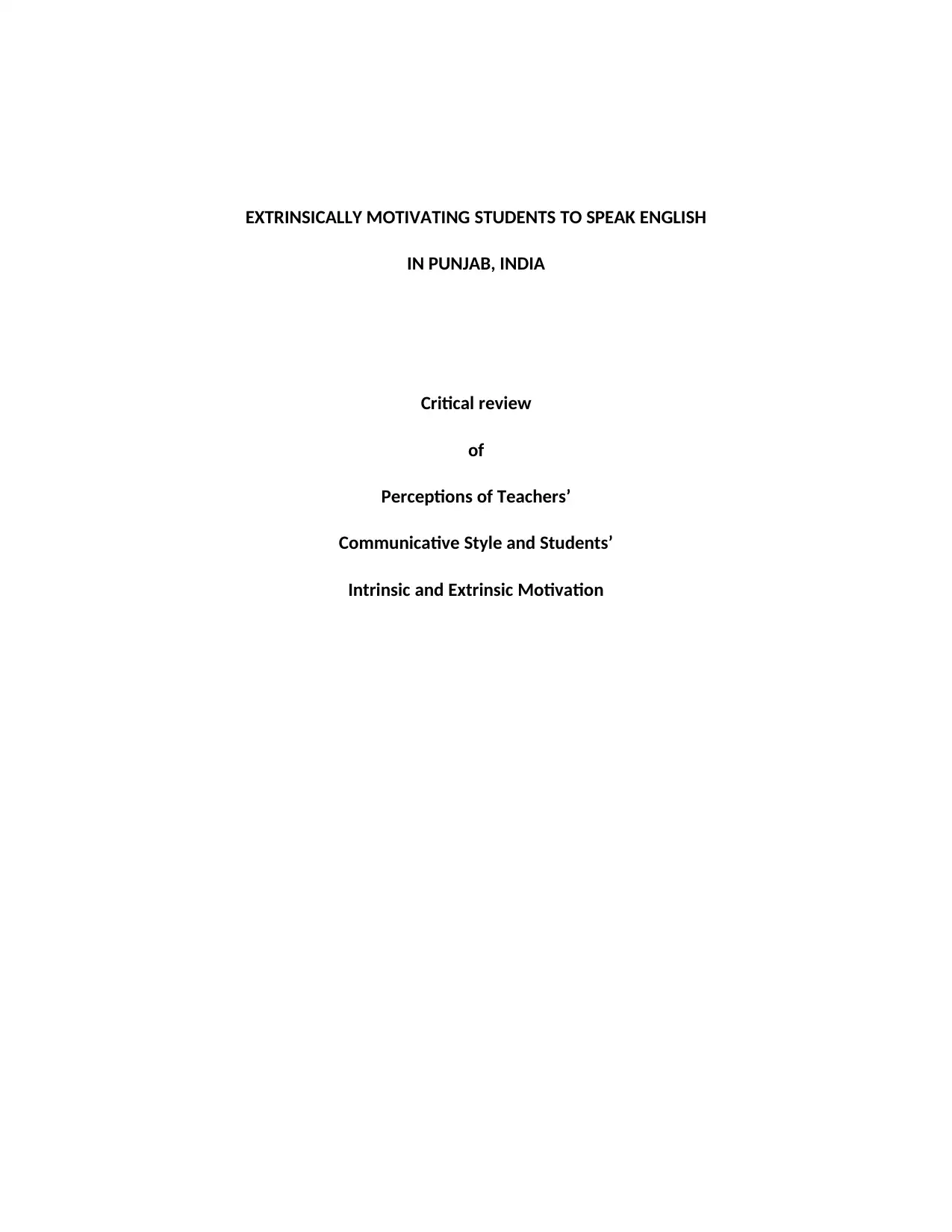
EXTRINSICALLY MOTIVATING STUDENTS TO SPEAK ENGLISH
IN PUNJAB, INDIA
Critical review
of
Perceptions of Teachers’
Communicative Style and Students’
Intrinsic and Extrinsic Motivation
IN PUNJAB, INDIA
Critical review
of
Perceptions of Teachers’
Communicative Style and Students’
Intrinsic and Extrinsic Motivation
Paraphrase This Document
Need a fresh take? Get an instant paraphrase of this document with our AI Paraphraser
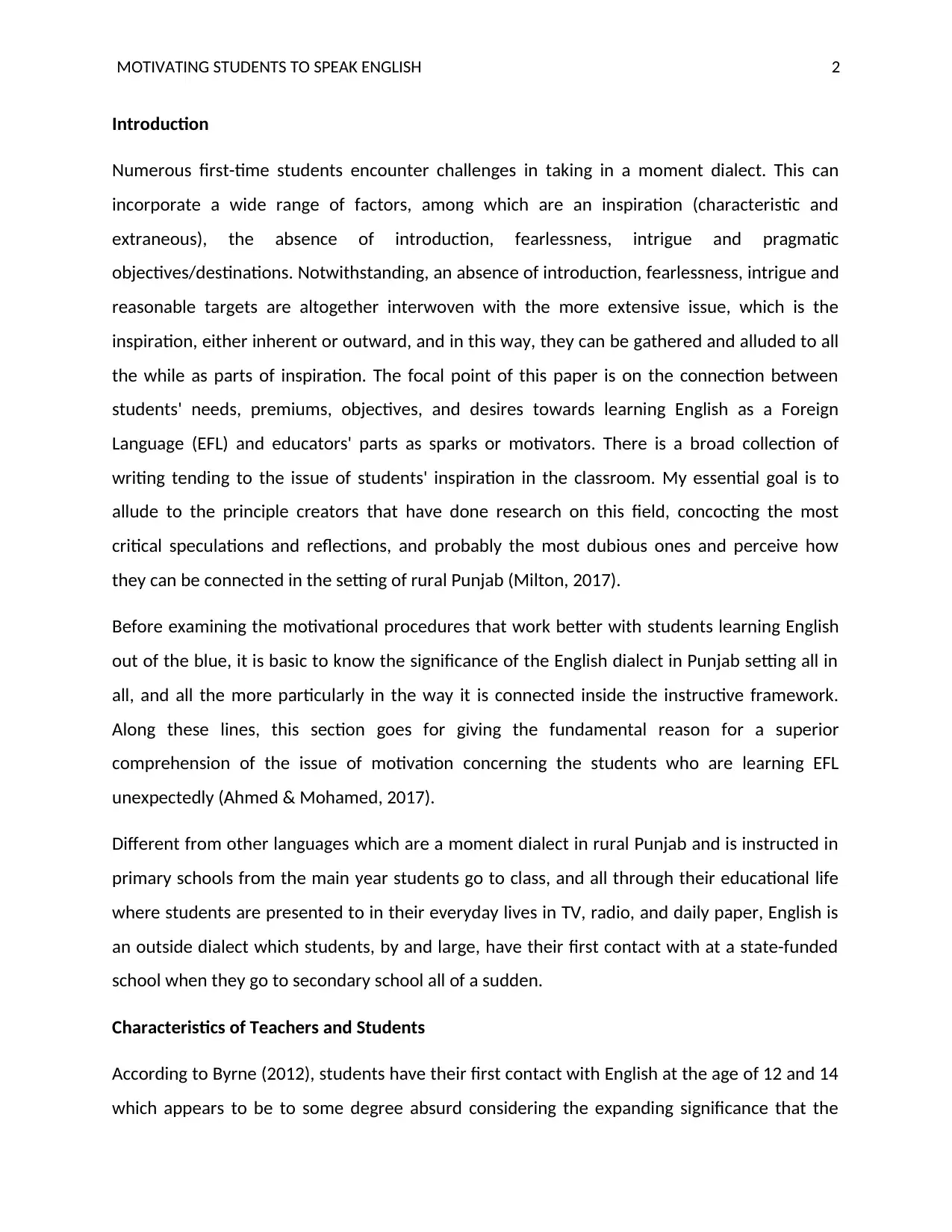
MOTIVATING STUDENTS TO SPEAK ENGLISH 2
Introduction
Numerous first-time students encounter challenges in taking in a moment dialect. This can
incorporate a wide range of factors, among which are an inspiration (characteristic and
extraneous), the absence of introduction, fearlessness, intrigue and pragmatic
objectives/destinations. Notwithstanding, an absence of introduction, fearlessness, intrigue and
reasonable targets are altogether interwoven with the more extensive issue, which is the
inspiration, either inherent or outward, and in this way, they can be gathered and alluded to all
the while as parts of inspiration. The focal point of this paper is on the connection between
students' needs, premiums, objectives, and desires towards learning English as a Foreign
Language (EFL) and educators' parts as sparks or motivators. There is a broad collection of
writing tending to the issue of students' inspiration in the classroom. My essential goal is to
allude to the principle creators that have done research on this field, concocting the most
critical speculations and reflections, and probably the most dubious ones and perceive how
they can be connected in the setting of rural Punjab (Milton, 2017).
Before examining the motivational procedures that work better with students learning English
out of the blue, it is basic to know the significance of the English dialect in Punjab setting all in
all, and all the more particularly in the way it is connected inside the instructive framework.
Along these lines, this section goes for giving the fundamental reason for a superior
comprehension of the issue of motivation concerning the students who are learning EFL
unexpectedly (Ahmed & Mohamed, 2017).
Different from other languages which are a moment dialect in rural Punjab and is instructed in
primary schools from the main year students go to class, and all through their educational life
where students are presented to in their everyday lives in TV, radio, and daily paper, English is
an outside dialect which students, by and large, have their first contact with at a state-funded
school when they go to secondary school all of a sudden.
Characteristics of Teachers and Students
According to Byrne (2012), students have their first contact with English at the age of 12 and 14
which appears to be to some degree absurd considering the expanding significance that the
Introduction
Numerous first-time students encounter challenges in taking in a moment dialect. This can
incorporate a wide range of factors, among which are an inspiration (characteristic and
extraneous), the absence of introduction, fearlessness, intrigue and pragmatic
objectives/destinations. Notwithstanding, an absence of introduction, fearlessness, intrigue and
reasonable targets are altogether interwoven with the more extensive issue, which is the
inspiration, either inherent or outward, and in this way, they can be gathered and alluded to all
the while as parts of inspiration. The focal point of this paper is on the connection between
students' needs, premiums, objectives, and desires towards learning English as a Foreign
Language (EFL) and educators' parts as sparks or motivators. There is a broad collection of
writing tending to the issue of students' inspiration in the classroom. My essential goal is to
allude to the principle creators that have done research on this field, concocting the most
critical speculations and reflections, and probably the most dubious ones and perceive how
they can be connected in the setting of rural Punjab (Milton, 2017).
Before examining the motivational procedures that work better with students learning English
out of the blue, it is basic to know the significance of the English dialect in Punjab setting all in
all, and all the more particularly in the way it is connected inside the instructive framework.
Along these lines, this section goes for giving the fundamental reason for a superior
comprehension of the issue of motivation concerning the students who are learning EFL
unexpectedly (Ahmed & Mohamed, 2017).
Different from other languages which are a moment dialect in rural Punjab and is instructed in
primary schools from the main year students go to class, and all through their educational life
where students are presented to in their everyday lives in TV, radio, and daily paper, English is
an outside dialect which students, by and large, have their first contact with at a state-funded
school when they go to secondary school all of a sudden.
Characteristics of Teachers and Students
According to Byrne (2012), students have their first contact with English at the age of 12 and 14
which appears to be to some degree absurd considering the expanding significance that the
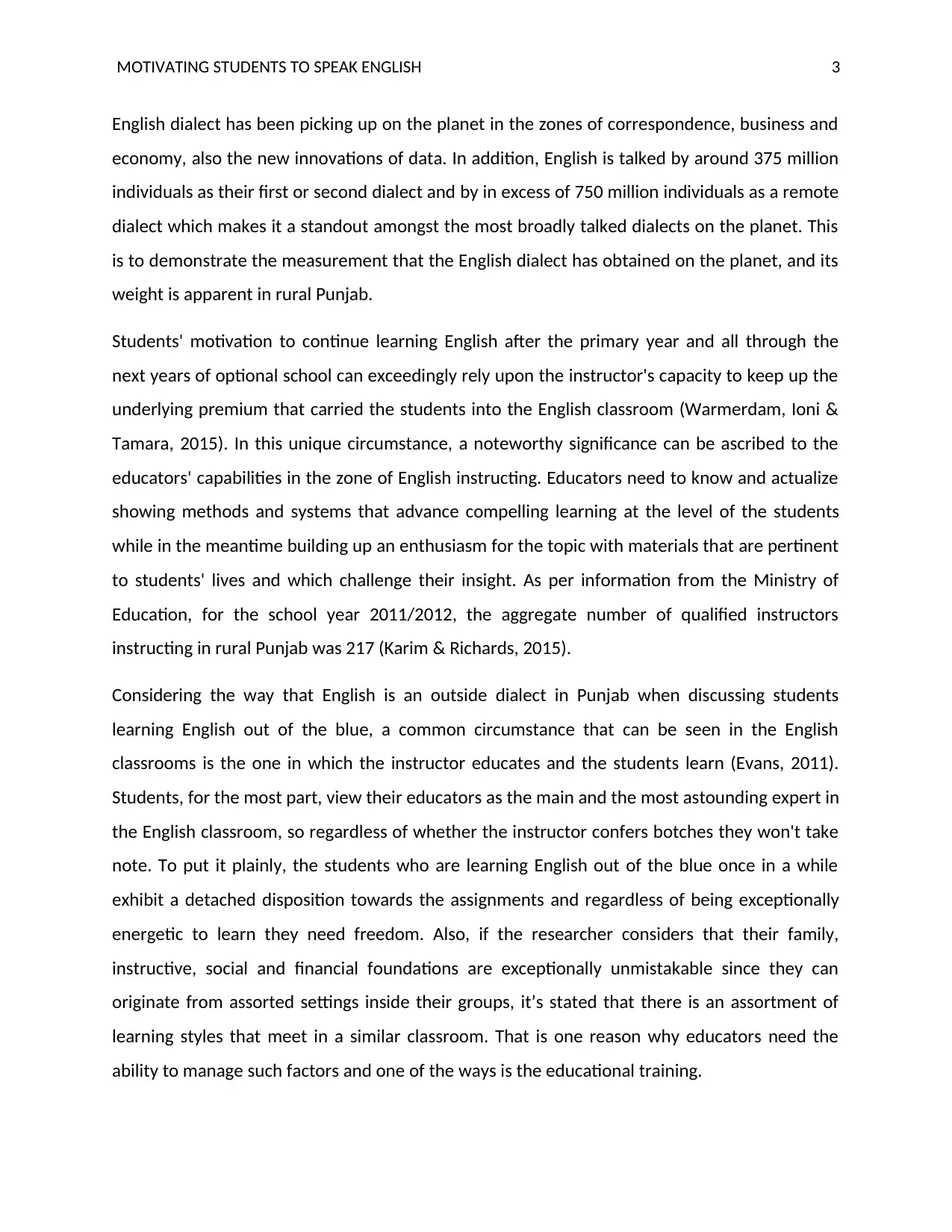
MOTIVATING STUDENTS TO SPEAK ENGLISH 3
English dialect has been picking up on the planet in the zones of correspondence, business and
economy, also the new innovations of data. In addition, English is talked by around 375 million
individuals as their first or second dialect and by in excess of 750 million individuals as a remote
dialect which makes it a standout amongst the most broadly talked dialects on the planet. This
is to demonstrate the measurement that the English dialect has obtained on the planet, and its
weight is apparent in rural Punjab.
Students' motivation to continue learning English after the primary year and all through the
next years of optional school can exceedingly rely upon the instructor's capacity to keep up the
underlying premium that carried the students into the English classroom (Warmerdam, Ioni &
Tamara, 2015). In this unique circumstance, a noteworthy significance can be ascribed to the
educators' capabilities in the zone of English instructing. Educators need to know and actualize
showing methods and systems that advance compelling learning at the level of the students
while in the meantime building up an enthusiasm for the topic with materials that are pertinent
to students' lives and which challenge their insight. As per information from the Ministry of
Education, for the school year 2011/2012, the aggregate number of qualified instructors
instructing in rural Punjab was 217 (Karim & Richards, 2015).
Considering the way that English is an outside dialect in Punjab when discussing students
learning English out of the blue, a common circumstance that can be seen in the English
classrooms is the one in which the instructor educates and the students learn (Evans, 2011).
Students, for the most part, view their educators as the main and the most astounding expert in
the English classroom, so regardless of whether the instructor confers botches they won't take
note. To put it plainly, the students who are learning English out of the blue once in a while
exhibit a detached disposition towards the assignments and regardless of being exceptionally
energetic to learn they need freedom. Also, if the researcher considers that their family,
instructive, social and financial foundations are exceptionally unmistakable since they can
originate from assorted settings inside their groups, it’s stated that there is an assortment of
learning styles that meet in a similar classroom. That is one reason why educators need the
ability to manage such factors and one of the ways is the educational training.
English dialect has been picking up on the planet in the zones of correspondence, business and
economy, also the new innovations of data. In addition, English is talked by around 375 million
individuals as their first or second dialect and by in excess of 750 million individuals as a remote
dialect which makes it a standout amongst the most broadly talked dialects on the planet. This
is to demonstrate the measurement that the English dialect has obtained on the planet, and its
weight is apparent in rural Punjab.
Students' motivation to continue learning English after the primary year and all through the
next years of optional school can exceedingly rely upon the instructor's capacity to keep up the
underlying premium that carried the students into the English classroom (Warmerdam, Ioni &
Tamara, 2015). In this unique circumstance, a noteworthy significance can be ascribed to the
educators' capabilities in the zone of English instructing. Educators need to know and actualize
showing methods and systems that advance compelling learning at the level of the students
while in the meantime building up an enthusiasm for the topic with materials that are pertinent
to students' lives and which challenge their insight. As per information from the Ministry of
Education, for the school year 2011/2012, the aggregate number of qualified instructors
instructing in rural Punjab was 217 (Karim & Richards, 2015).
Considering the way that English is an outside dialect in Punjab when discussing students
learning English out of the blue, a common circumstance that can be seen in the English
classrooms is the one in which the instructor educates and the students learn (Evans, 2011).
Students, for the most part, view their educators as the main and the most astounding expert in
the English classroom, so regardless of whether the instructor confers botches they won't take
note. To put it plainly, the students who are learning English out of the blue once in a while
exhibit a detached disposition towards the assignments and regardless of being exceptionally
energetic to learn they need freedom. Also, if the researcher considers that their family,
instructive, social and financial foundations are exceptionally unmistakable since they can
originate from assorted settings inside their groups, it’s stated that there is an assortment of
learning styles that meet in a similar classroom. That is one reason why educators need the
ability to manage such factors and one of the ways is the educational training.
⊘ This is a preview!⊘
Do you want full access?
Subscribe today to unlock all pages.

Trusted by 1+ million students worldwide
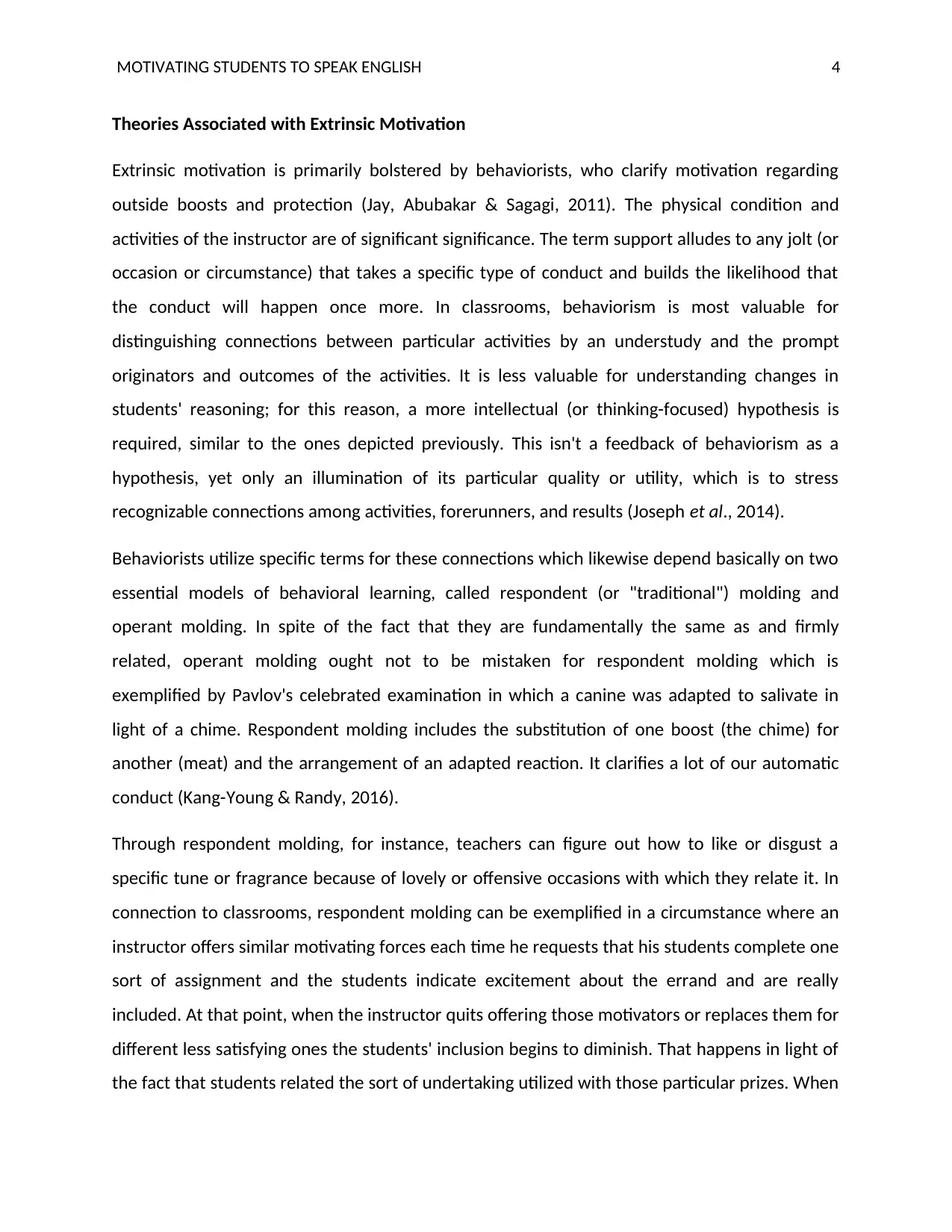
MOTIVATING STUDENTS TO SPEAK ENGLISH 4
Theories Associated with Extrinsic Motivation
Extrinsic motivation is primarily bolstered by behaviorists, who clarify motivation regarding
outside boosts and protection (Jay, Abubakar & Sagagi, 2011). The physical condition and
activities of the instructor are of significant significance. The term support alludes to any jolt (or
occasion or circumstance) that takes a specific type of conduct and builds the likelihood that
the conduct will happen once more. In classrooms, behaviorism is most valuable for
distinguishing connections between particular activities by an understudy and the prompt
originators and outcomes of the activities. It is less valuable for understanding changes in
students' reasoning; for this reason, a more intellectual (or thinking-focused) hypothesis is
required, similar to the ones depicted previously. This isn't a feedback of behaviorism as a
hypothesis, yet only an illumination of its particular quality or utility, which is to stress
recognizable connections among activities, forerunners, and results (Joseph et al., 2014).
Behaviorists utilize specific terms for these connections which likewise depend basically on two
essential models of behavioral learning, called respondent (or "traditional") molding and
operant molding. In spite of the fact that they are fundamentally the same as and firmly
related, operant molding ought not to be mistaken for respondent molding which is
exemplified by Pavlov's celebrated examination in which a canine was adapted to salivate in
light of a chime. Respondent molding includes the substitution of one boost (the chime) for
another (meat) and the arrangement of an adapted reaction. It clarifies a lot of our automatic
conduct (Kang-Young & Randy, 2016).
Through respondent molding, for instance, teachers can figure out how to like or disgust a
specific tune or fragrance because of lovely or offensive occasions with which they relate it. In
connection to classrooms, respondent molding can be exemplified in a circumstance where an
instructor offers similar motivating forces each time he requests that his students complete one
sort of assignment and the students indicate excitement about the errand and are really
included. At that point, when the instructor quits offering those motivators or replaces them for
different less satisfying ones the students' inclusion begins to diminish. That happens in light of
the fact that students related the sort of undertaking utilized with those particular prizes. When
Theories Associated with Extrinsic Motivation
Extrinsic motivation is primarily bolstered by behaviorists, who clarify motivation regarding
outside boosts and protection (Jay, Abubakar & Sagagi, 2011). The physical condition and
activities of the instructor are of significant significance. The term support alludes to any jolt (or
occasion or circumstance) that takes a specific type of conduct and builds the likelihood that
the conduct will happen once more. In classrooms, behaviorism is most valuable for
distinguishing connections between particular activities by an understudy and the prompt
originators and outcomes of the activities. It is less valuable for understanding changes in
students' reasoning; for this reason, a more intellectual (or thinking-focused) hypothesis is
required, similar to the ones depicted previously. This isn't a feedback of behaviorism as a
hypothesis, yet only an illumination of its particular quality or utility, which is to stress
recognizable connections among activities, forerunners, and results (Joseph et al., 2014).
Behaviorists utilize specific terms for these connections which likewise depend basically on two
essential models of behavioral learning, called respondent (or "traditional") molding and
operant molding. In spite of the fact that they are fundamentally the same as and firmly
related, operant molding ought not to be mistaken for respondent molding which is
exemplified by Pavlov's celebrated examination in which a canine was adapted to salivate in
light of a chime. Respondent molding includes the substitution of one boost (the chime) for
another (meat) and the arrangement of an adapted reaction. It clarifies a lot of our automatic
conduct (Kang-Young & Randy, 2016).
Through respondent molding, for instance, teachers can figure out how to like or disgust a
specific tune or fragrance because of lovely or offensive occasions with which they relate it. In
connection to classrooms, respondent molding can be exemplified in a circumstance where an
instructor offers similar motivating forces each time he requests that his students complete one
sort of assignment and the students indicate excitement about the errand and are really
included. At that point, when the instructor quits offering those motivators or replaces them for
different less satisfying ones the students' inclusion begins to diminish. That happens in light of
the fact that students related the sort of undertaking utilized with those particular prizes. When
Paraphrase This Document
Need a fresh take? Get an instant paraphrase of this document with our AI Paraphraser
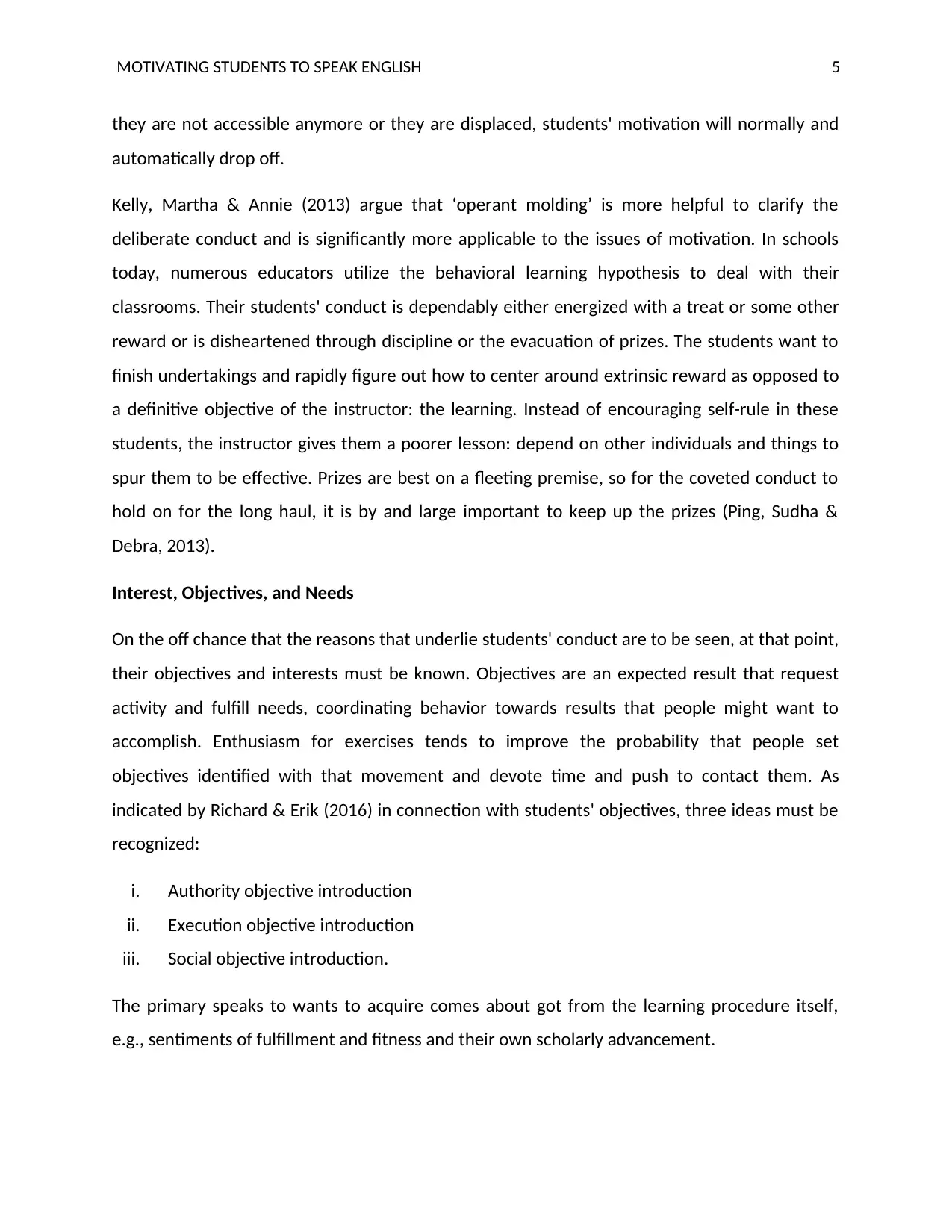
MOTIVATING STUDENTS TO SPEAK ENGLISH 5
they are not accessible anymore or they are displaced, students' motivation will normally and
automatically drop off.
Kelly, Martha & Annie (2013) argue that ‘operant molding’ is more helpful to clarify the
deliberate conduct and is significantly more applicable to the issues of motivation. In schools
today, numerous educators utilize the behavioral learning hypothesis to deal with their
classrooms. Their students' conduct is dependably either energized with a treat or some other
reward or is disheartened through discipline or the evacuation of prizes. The students want to
finish undertakings and rapidly figure out how to center around extrinsic reward as opposed to
a definitive objective of the instructor: the learning. Instead of encouraging self-rule in these
students, the instructor gives them a poorer lesson: depend on other individuals and things to
spur them to be effective. Prizes are best on a fleeting premise, so for the coveted conduct to
hold on for the long haul, it is by and large important to keep up the prizes (Ping, Sudha &
Debra, 2013).
Interest, Objectives, and Needs
On the off chance that the reasons that underlie students' conduct are to be seen, at that point,
their objectives and interests must be known. Objectives are an expected result that request
activity and fulfill needs, coordinating behavior towards results that people might want to
accomplish. Enthusiasm for exercises tends to improve the probability that people set
objectives identified with that movement and devote time and push to contact them. As
indicated by Richard & Erik (2016) in connection with students' objectives, three ideas must be
recognized:
i. Authority objective introduction
ii. Execution objective introduction
iii. Social objective introduction.
The primary speaks to wants to acquire comes about got from the learning procedure itself,
e.g., sentiments of fulfillment and fitness and their own scholarly advancement.
they are not accessible anymore or they are displaced, students' motivation will normally and
automatically drop off.
Kelly, Martha & Annie (2013) argue that ‘operant molding’ is more helpful to clarify the
deliberate conduct and is significantly more applicable to the issues of motivation. In schools
today, numerous educators utilize the behavioral learning hypothesis to deal with their
classrooms. Their students' conduct is dependably either energized with a treat or some other
reward or is disheartened through discipline or the evacuation of prizes. The students want to
finish undertakings and rapidly figure out how to center around extrinsic reward as opposed to
a definitive objective of the instructor: the learning. Instead of encouraging self-rule in these
students, the instructor gives them a poorer lesson: depend on other individuals and things to
spur them to be effective. Prizes are best on a fleeting premise, so for the coveted conduct to
hold on for the long haul, it is by and large important to keep up the prizes (Ping, Sudha &
Debra, 2013).
Interest, Objectives, and Needs
On the off chance that the reasons that underlie students' conduct are to be seen, at that point,
their objectives and interests must be known. Objectives are an expected result that request
activity and fulfill needs, coordinating behavior towards results that people might want to
accomplish. Enthusiasm for exercises tends to improve the probability that people set
objectives identified with that movement and devote time and push to contact them. As
indicated by Richard & Erik (2016) in connection with students' objectives, three ideas must be
recognized:
i. Authority objective introduction
ii. Execution objective introduction
iii. Social objective introduction.
The primary speaks to wants to acquire comes about got from the learning procedure itself,
e.g., sentiments of fulfillment and fitness and their own scholarly advancement.
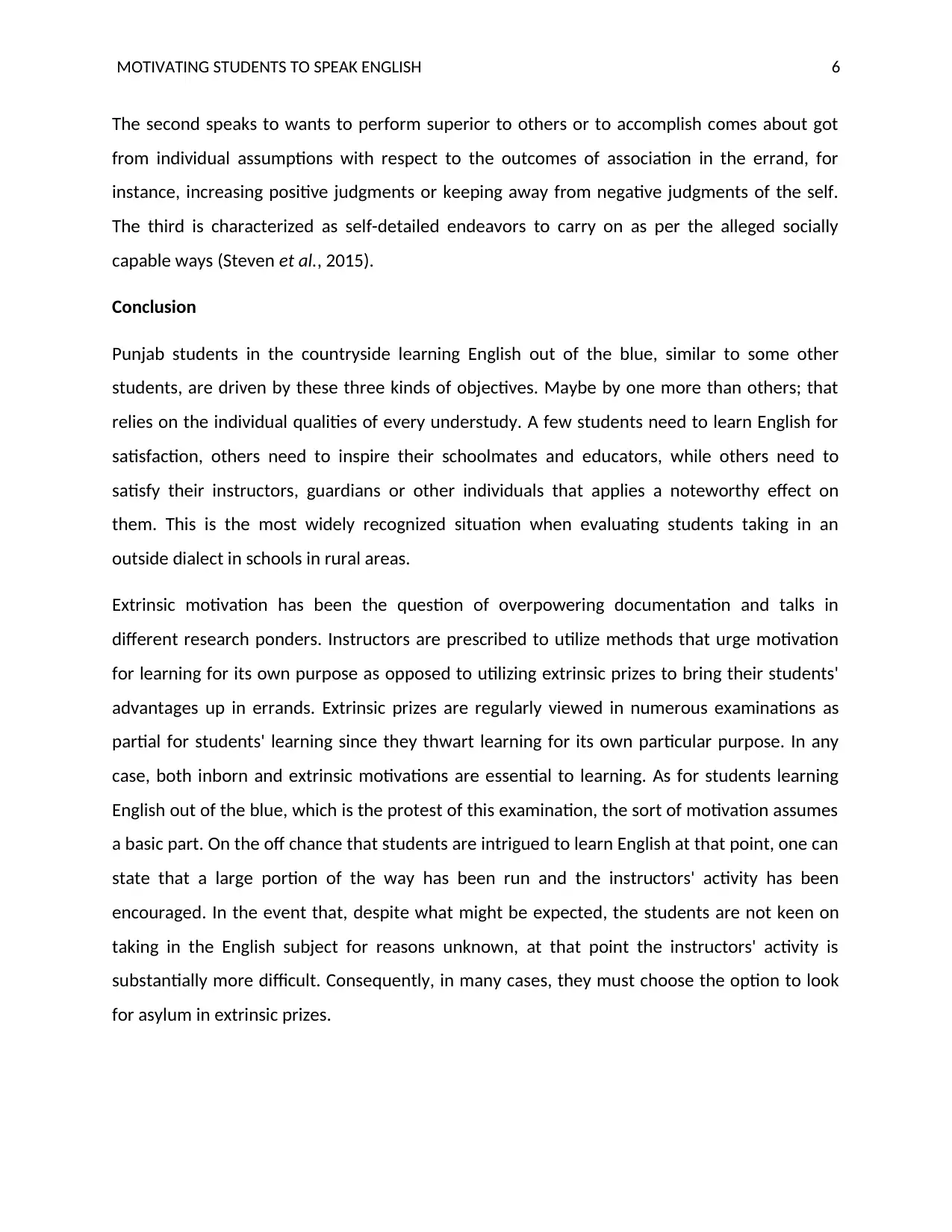
MOTIVATING STUDENTS TO SPEAK ENGLISH 6
The second speaks to wants to perform superior to others or to accomplish comes about got
from individual assumptions with respect to the outcomes of association in the errand, for
instance, increasing positive judgments or keeping away from negative judgments of the self.
The third is characterized as self-detailed endeavors to carry on as per the alleged socially
capable ways (Steven et al., 2015).
Conclusion
Punjab students in the countryside learning English out of the blue, similar to some other
students, are driven by these three kinds of objectives. Maybe by one more than others; that
relies on the individual qualities of every understudy. A few students need to learn English for
satisfaction, others need to inspire their schoolmates and educators, while others need to
satisfy their instructors, guardians or other individuals that applies a noteworthy effect on
them. This is the most widely recognized situation when evaluating students taking in an
outside dialect in schools in rural areas.
Extrinsic motivation has been the question of overpowering documentation and talks in
different research ponders. Instructors are prescribed to utilize methods that urge motivation
for learning for its own purpose as opposed to utilizing extrinsic prizes to bring their students'
advantages up in errands. Extrinsic prizes are regularly viewed in numerous examinations as
partial for students' learning since they thwart learning for its own particular purpose. In any
case, both inborn and extrinsic motivations are essential to learning. As for students learning
English out of the blue, which is the protest of this examination, the sort of motivation assumes
a basic part. On the off chance that students are intrigued to learn English at that point, one can
state that a large portion of the way has been run and the instructors' activity has been
encouraged. In the event that, despite what might be expected, the students are not keen on
taking in the English subject for reasons unknown, at that point the instructors' activity is
substantially more difficult. Consequently, in many cases, they must choose the option to look
for asylum in extrinsic prizes.
The second speaks to wants to perform superior to others or to accomplish comes about got
from individual assumptions with respect to the outcomes of association in the errand, for
instance, increasing positive judgments or keeping away from negative judgments of the self.
The third is characterized as self-detailed endeavors to carry on as per the alleged socially
capable ways (Steven et al., 2015).
Conclusion
Punjab students in the countryside learning English out of the blue, similar to some other
students, are driven by these three kinds of objectives. Maybe by one more than others; that
relies on the individual qualities of every understudy. A few students need to learn English for
satisfaction, others need to inspire their schoolmates and educators, while others need to
satisfy their instructors, guardians or other individuals that applies a noteworthy effect on
them. This is the most widely recognized situation when evaluating students taking in an
outside dialect in schools in rural areas.
Extrinsic motivation has been the question of overpowering documentation and talks in
different research ponders. Instructors are prescribed to utilize methods that urge motivation
for learning for its own purpose as opposed to utilizing extrinsic prizes to bring their students'
advantages up in errands. Extrinsic prizes are regularly viewed in numerous examinations as
partial for students' learning since they thwart learning for its own particular purpose. In any
case, both inborn and extrinsic motivations are essential to learning. As for students learning
English out of the blue, which is the protest of this examination, the sort of motivation assumes
a basic part. On the off chance that students are intrigued to learn English at that point, one can
state that a large portion of the way has been run and the instructors' activity has been
encouraged. In the event that, despite what might be expected, the students are not keen on
taking in the English subject for reasons unknown, at that point the instructors' activity is
substantially more difficult. Consequently, in many cases, they must choose the option to look
for asylum in extrinsic prizes.
⊘ This is a preview!⊘
Do you want full access?
Subscribe today to unlock all pages.

Trusted by 1+ million students worldwide
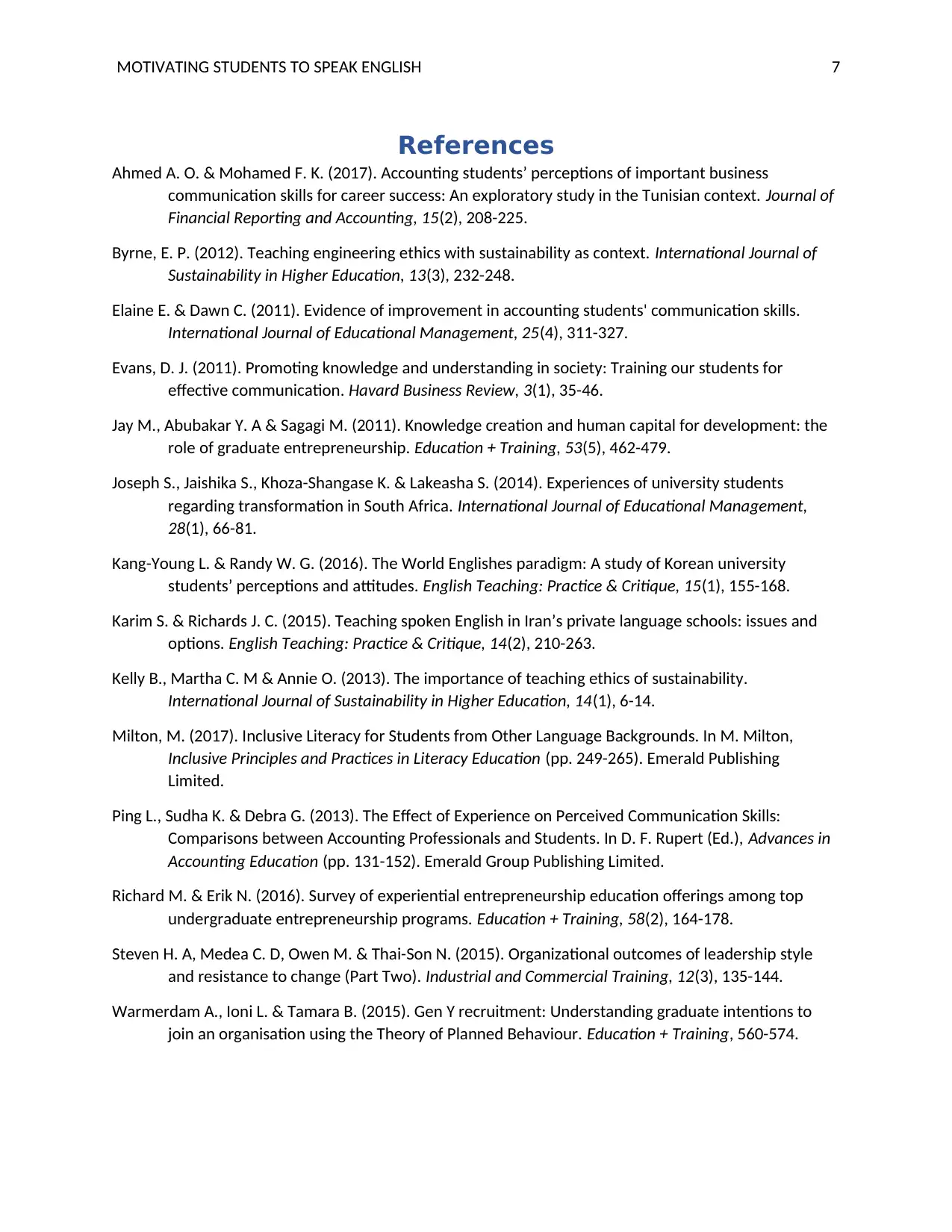
MOTIVATING STUDENTS TO SPEAK ENGLISH 7
References
Ahmed A. O. & Mohamed F. K. (2017). Accounting students’ perceptions of important business
communication skills for career success: An exploratory study in the Tunisian context. Journal of
Financial Reporting and Accounting, 15(2), 208-225.
Byrne, E. P. (2012). Teaching engineering ethics with sustainability as context. International Journal of
Sustainability in Higher Education, 13(3), 232-248.
Elaine E. & Dawn C. (2011). Evidence of improvement in accounting students' communication skills.
International Journal of Educational Management, 25(4), 311-327.
Evans, D. J. (2011). Promoting knowledge and understanding in society: Training our students for
effective communication. Havard Business Review, 3(1), 35-46.
Jay M., Abubakar Y. A & Sagagi M. (2011). Knowledge creation and human capital for development: the
role of graduate entrepreneurship. Education + Training, 53(5), 462-479.
Joseph S., Jaishika S., Khoza-Shangase K. & Lakeasha S. (2014). Experiences of university students
regarding transformation in South Africa. International Journal of Educational Management,
28(1), 66-81.
Kang-Young L. & Randy W. G. (2016). The World Englishes paradigm: A study of Korean university
students’ perceptions and attitudes. English Teaching: Practice & Critique, 15(1), 155-168.
Karim S. & Richards J. C. (2015). Teaching spoken English in Iran’s private language schools: issues and
options. English Teaching: Practice & Critique, 14(2), 210-263.
Kelly B., Martha C. M & Annie O. (2013). The importance of teaching ethics of sustainability.
International Journal of Sustainability in Higher Education, 14(1), 6-14.
Milton, M. (2017). Inclusive Literacy for Students from Other Language Backgrounds. In M. Milton,
Inclusive Principles and Practices in Literacy Education (pp. 249-265). Emerald Publishing
Limited.
Ping L., Sudha K. & Debra G. (2013). The Effect of Experience on Perceived Communication Skills:
Comparisons between Accounting Professionals and Students. In D. F. Rupert (Ed.), Advances in
Accounting Education (pp. 131-152). Emerald Group Publishing Limited.
Richard M. & Erik N. (2016). Survey of experiential entrepreneurship education offerings among top
undergraduate entrepreneurship programs. Education + Training, 58(2), 164-178.
Steven H. A, Medea C. D, Owen M. & Thai-Son N. (2015). Organizational outcomes of leadership style
and resistance to change (Part Two). Industrial and Commercial Training, 12(3), 135-144.
Warmerdam A., Ioni L. & Tamara B. (2015). Gen Y recruitment: Understanding graduate intentions to
join an organisation using the Theory of Planned Behaviour. Education + Training, 560-574.
References
Ahmed A. O. & Mohamed F. K. (2017). Accounting students’ perceptions of important business
communication skills for career success: An exploratory study in the Tunisian context. Journal of
Financial Reporting and Accounting, 15(2), 208-225.
Byrne, E. P. (2012). Teaching engineering ethics with sustainability as context. International Journal of
Sustainability in Higher Education, 13(3), 232-248.
Elaine E. & Dawn C. (2011). Evidence of improvement in accounting students' communication skills.
International Journal of Educational Management, 25(4), 311-327.
Evans, D. J. (2011). Promoting knowledge and understanding in society: Training our students for
effective communication. Havard Business Review, 3(1), 35-46.
Jay M., Abubakar Y. A & Sagagi M. (2011). Knowledge creation and human capital for development: the
role of graduate entrepreneurship. Education + Training, 53(5), 462-479.
Joseph S., Jaishika S., Khoza-Shangase K. & Lakeasha S. (2014). Experiences of university students
regarding transformation in South Africa. International Journal of Educational Management,
28(1), 66-81.
Kang-Young L. & Randy W. G. (2016). The World Englishes paradigm: A study of Korean university
students’ perceptions and attitudes. English Teaching: Practice & Critique, 15(1), 155-168.
Karim S. & Richards J. C. (2015). Teaching spoken English in Iran’s private language schools: issues and
options. English Teaching: Practice & Critique, 14(2), 210-263.
Kelly B., Martha C. M & Annie O. (2013). The importance of teaching ethics of sustainability.
International Journal of Sustainability in Higher Education, 14(1), 6-14.
Milton, M. (2017). Inclusive Literacy for Students from Other Language Backgrounds. In M. Milton,
Inclusive Principles and Practices in Literacy Education (pp. 249-265). Emerald Publishing
Limited.
Ping L., Sudha K. & Debra G. (2013). The Effect of Experience on Perceived Communication Skills:
Comparisons between Accounting Professionals and Students. In D. F. Rupert (Ed.), Advances in
Accounting Education (pp. 131-152). Emerald Group Publishing Limited.
Richard M. & Erik N. (2016). Survey of experiential entrepreneurship education offerings among top
undergraduate entrepreneurship programs. Education + Training, 58(2), 164-178.
Steven H. A, Medea C. D, Owen M. & Thai-Son N. (2015). Organizational outcomes of leadership style
and resistance to change (Part Two). Industrial and Commercial Training, 12(3), 135-144.
Warmerdam A., Ioni L. & Tamara B. (2015). Gen Y recruitment: Understanding graduate intentions to
join an organisation using the Theory of Planned Behaviour. Education + Training, 560-574.
1 out of 7
Your All-in-One AI-Powered Toolkit for Academic Success.
+13062052269
info@desklib.com
Available 24*7 on WhatsApp / Email
![[object Object]](/_next/static/media/star-bottom.7253800d.svg)
Unlock your academic potential
Copyright © 2020–2025 A2Z Services. All Rights Reserved. Developed and managed by ZUCOL.